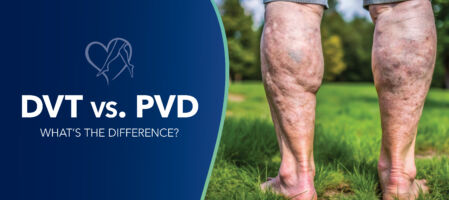
Deep vein thrombosis (DVT) and peripheral vascular disease (PVD) are two common vascular conditions often confused due to their similarities. However, understanding the key differences between DVT and PVD is critical, especially when it comes to diagnosis, treatment, and prevention. This article will explore each condition's unique characteristics, clarifying how they differ, the risk factors involved, and the symptoms to watch for.
Deep vein thrombosis (DVT) is when a blood clot forms in a deep vein, usually in the legs. It is a serious condition because these clots can break loose, travel through the bloodstream, and lodge in the lungs, causing a life-threatening pulmonary embolism (PE).
DVT occurs when blood flow slows down in the deep veins, creating the perfect environment for a clot to form. These clots most often develop in the lower leg, thigh, or pelvis, though they can also appear in other parts of the body.
Recognizing DVT symptoms early is crucial for prompt treatment. Common symptoms of DVT in the leg include:
If you notice any of these symptoms, seek medical attention immediately, as untreated DVT can lead to serious complications.
Don't delay! Call the Center for Vein Restoration's DVT hotline at 877-SCAN-DVT (877-722-6388).
Center for Vein Restoration (CVR), America's largest physician-led vein center dedicated to comprehensive treatment for chronic venous insufficiency, offers a DVT rule-out service for individuals who suspect they have a DVT. This one-stop management approach helps those concerned about their DVT risk avoid a lengthy and costly trip to the emergency room.
The DVT rule-out appointment includes a scan and treatment anticoagulation, education, and follow-up if needed. Call the DVT hotline at 877-SCAN-DVT (877-722-6388).
According to Johns Hopkins Medicine, peripheral vascular disease (PVD) refers to disorders that affect the blood vessels outside the heart and brain, primarily impacting the arteries that supply blood to the arms, legs, and organs.
PVD is commonly caused by atherosclerosis, where plaque builds up inside the arteries, narrowing them and reducing blood flow. Reduced blood flow can lead to symptoms such as pain or cramping in the legs during activity (known as claudication), numbness, weakness, and coldness in the limbs. If left untreated, PVD can result in severe complications like ulcers, tissue damage, and even limb amputation.
The Mayo Clinic points out that while atherosclerosis is often considered a heart problem, it can affect arteries anywhere in the body. Fortunately, the condition can be managed through healthy lifestyle changes and medications. In severe cases, surgical procedures are typically used to restore proper blood circulation.
Unlike DVT, which is a problem with the veins, PVD mainly concerns the arteries. Although both conditions can cause leg pain, the nature and underlying causes differ significantly.
According to Yale Medicine, peripheral vascular disease is primarily caused by smoking, high blood pressure, high cholesterol, and type 2 diabetes. Men over 50 and postmenopausal women are at higher risk, especially if they smoke, are overweight, inactive, or have conditions like diabetes, hypertension, or kidney disease.
Symptoms of PVD are often mistaken for those of DVT, but they stem from arterial blockages rather than venous issues. Common signs of PVD include:
While PVD is less immediately life-threatening than DVT, it can lead to serious complications if left untreated, including chronic pain, ulcers, and even the need for amputation.
While both DVT and PVD affect the circulatory system, the distinctions are important:
Chronic venous insufficiency (CVI) is a venous condition that sometimes overlaps with DVT. CVI occurs when the veins in the legs fail to adequately return blood to the heart, leading to pooling in the legs. Also known as vein disease, individuals with CVI may have a higher risk for DVT because poor blood flow can contribute to blood clot formation. Addressing underlying CVI is crucial for reducing the risk of DVT recurrence.
Don't let CVI or vein disease increase your risk for serious conditions like deep vein thrombosis. At Center for Vein Restoration, our vein specialists provide expert diagnosis and personalized treatment plans to help you maintain healthy veins and overall well-being.
Call 240-965-3915 to speak to a Patient Services Representative or schedule your consultation online at a CVR near you today.

Proper diagnosis is essential for both DVT and PVD, as the treatments differ significantly.
Preventing these conditions involves managing risk factors:
While DVT and PVD both involve issues within the circulatory system, they affect different types of blood vessels and have distinct causes, symptoms, and treatments. Understanding these differences is critical to effective prevention and management. Early detection and appropriate medical care can significantly reduce the risks associated with these conditions, improving quality of life and long-term health outcomes.
Vein disease can significantly increase your risk of developing deep vein thrombosis, a potentially dangerous condition if left untreated. At Center for Vein Restoration, our team of dedicated specialists is here to provide the expert care and attention you need. Using advanced diagnostic techniques and personalized treatment plans, we address the root causes of your vein problems to restore healthy circulation and enhance your quality of life.
Call 240-965-3915 to speak to a Patient Services Representative or schedule your consultation online at a CVR near you today.
